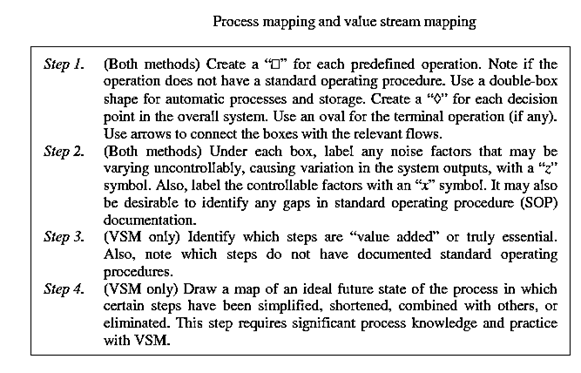Analyze Phase
Introduction:
The analyze phase involves establishing cause-and-effect relationships between system inputs and outputs. Several relevant methods use different data sources and generate different visual information for decision-makers.
Process Mapping and Value Stream Mapping:
I. The “process mapping” method involves creating flow diagrams of systems.
II. Among other benefits, this method clarifies possible causal relationships between subsystems, which are represented by blocks.
III. Inputs from some subsystems might influence outputs of downstream subsystems. This method is particularly useful in the define phase because subsystem inputs and outputs are identified during the mapping.
IV. Bottlenecks can also be clarified. Value stream mapping is also relevant in the analyze phase for similar reasons. Also, process mapping helps in setting up discrete event simulation models, which are a type of Monte Carlo method.
V. This topic is described thoroughly in Law and Kelton (2000) and Banks et al. (2000). Discrete event simulation plays a similar role to process mapping. Simulation also permits an investigation of bottlenecks in hypothetical situations with additional resources added such as new machines or people. To develop simulation models, data about processing times are generally required.
VI. The “Value Stream Mapping” (VSM) method can be viewed as a variant of process mapping with added activities.
VII. In VSM, engineers inspect the components of the engineered system, e.g., all process steps including material handling and rework, focusing on steps which could be simplified or eliminated.
VIII. The most popular references for this activity appear to be Womack and Jones (1996, 1999). Other potentially relevant references are Suzuki (1987) and Liker (1998).
IX. Therefore, value stream mapping involves analysis and also immediately suggests improvement through re-design. Other outputs of value stream mapping process described here include an expanded list of factors or system inputs to explore in experiments, as well as an evaluation of the documentation that supports the engineered system.
X. To paraphrase, the definition of “value stream” provided in Womack and Jones (1999) is the minimum amount of processing steps, from raw materials to the customer, needed to deliver the final product or system output. These necessary steps are called “value added” operations. All other steps are waste. For example, in making a hot dog, one might say that the minimum number of steps needed are two, heating the meat in water and packaging it in a bun.
XI. All material transport and movements related to collection of payments are not on the value stream and could conceivably be eliminated.

A natural next step is the transformation of the process to the ideal state. This would likely be considered as part of an improvement phase.